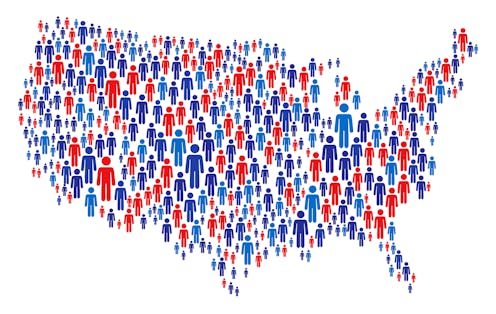
How people vote isn’t always reflected in how elections are decided. bamlou/DigitalVision Vectors via Getty Images
Republicans around the country are picking a nominee to run for president. However, their process – designed and run by the party, not government officials – is a mess of flawed mathematics that can end up delivering a result that’s in conflict with the person most voters actually support.
As a mathematics professor and co-founder of the Institute for Mathematics and Democracy, I watched this contradictory process play out in 2016, shaping the political landscape ever since. Elements of it are visible again in 2024.
There are many ways bad mathematics interferes with our democracy, as I explain in my forthcoming book, “Making Democracy Count: How Mathematics Improves Voting, Electoral Maps, and Representation.” Here’s how the Republican primaries can manage to defy democratic ideals and deliver a nominee even though most voters prefer someone else:
Splitting votes among many candidates
In 2016, former President Donald Trump became the Republican choice, having won 44.9% of the votes cast in primaries. That was nearly twice the share of votes won by the runner-up, Ted Cruz, who had 25.1% of the primary votes.
But during primary season, polls suggested that in head-to-head primaries, Trump would have lost not only to Cruz, but also to third-place Republican finisher John Kasich and Marco Rubio, who placed fourth.
In other words, a majority of Republican voters preferred Cruz, Kasich and Rubio to Trump. But none of the three took the lead because of the party’s nomination system, which assigned Trump 58.3% of the delegates at the Republican National Convention – the formal process by which the nominee is selected.
An attempt at proportional representation
The Republican Party says its primaries are meant to encourage proportional assignment of delegates to candidates. So if a candidate wins, say, 40% of the votes, she should win as close to 40% of the delegates as possible.
This sounds reasonable, and it aligns with most people’s notion of fairness. For primaries taking place before March 15, the Republican Party mandates proportional allocation, but with lots of exceptions that can effectively turn the election into winner-take-all or winner-take-most. After March 15, the exceptions become the norm, pulling the outcome further from proportional representation.
The Democratic Party has a more centralized system and mandates proportionality for all its primaries.
Crowd members cheer at the 2020 Republican National Convention.
Travis Dove/The New York Times via AP, Pool
Allocation of delegates
The process begins with the states each receiving a number of delegates that will later be assigned to candidates.
Each state gets 10 at-large delegates, and three delegates for each congressional district it contains. A state can also get additional delegates based on how Republican it is – depending on whether its people voted for a Republican presidential candidate in the previous general election, and on how much of its legislature is Republican.
These allocations can result in inequities. For instance, Massachusetts and Utah, two of the states voting on Super Tuesday, both get 40 delegates. That’s because Massachusetts has more congressional districts, while Utah is more Republican.
But Utah has roughly 960,000 registered Republican voters, and Massachusetts has about 440,000. That means for any candidate to get a Utah delegate would require support from at least twice as many voters as that candidate would need to get a Massachusetts delegate.
Assigning delegates to candidates
There are as many as seven different proportional methods used to assign states’ at-large delegates, each with its own mathematical problems. And in 21 states, the delegates allocated because of each congressional district are also assigned by the same methods as the at-large delegates.
In other states, the three delegates in each congressional district are all allocated to the winner in that district. And in still other states, the district delegates are allocated with a 2-1 split: The top vote-getter in the district receives two delegates and the runner-up receives one.
Math makes clear that these methods are not proportional representation: Imagine that three candidates in a close race get 33.5%, 33.3% and 33.2% of the votes, respectively. The winner-take-all method would give all three delegates to the top scorer. And in the 2-1 split, the last-place candidate would get nothing.
In some states, the party’s rules also allow the method of counting to vary depending on how dominant a candidate’s win is. For instance, California is the latest state to adopt the practice in which a candidate who wins more than half the statewide vote gets all of the state’s delegates.
Republican candidates for president appear at a debate in Milwaukee in August 2023.
AP Photo/Morry Gash
Two candidates doesn’t make the math clearer
The GOP’s system offers other significant advantages to winners as well.
Suppose a state has eight districts with three delegates apiece and in each, Candidate Alice gets 51% of the votes and Candidate Bob gets 49%. If the allocation was 2-1, Alice would get 16 delegates and Bob would get eight.
Then there are the 10 at-large delegates the party assigns to each state. Most proportional methods would split these delegates evenly, with five given to each candidate. That would deliver a grand total for Alice of 21 delegates, and 13 for Bob.
In that situation, Alice would get 51% of the votes but 62% of the delegates. This “winner’s bonus” was evident in many states Trump won in the 2016 primary, such as Alabama, where his vote share was 43% but he collected 72% of the delegates. In the 2020 Democratic primary races, Joe Biden won 51.6% of the votes and 68% of the delegates overall.
Winner-take-all is problematic too. Consider Utah and Massachusetts again. If a candidate won Utah by a landslide, and another narrowly won in Massachusetts, they would both get 40 delegates – based on vastly different numbers of actual votes cast by supporters.
An additional barrier
Most states also require candidates to get a certain percentage of voter support before being assigned any delegates at all. Under the Republican rules, some states set this bar as high as 20%. The Democratic Party mandates a 15% threshold for every state.
These thresholds are biased toward more popular candidates and can even cause mathematically counterintuitive delegate allocations.
The combination of winner-take-all and complicated threshold structures is where all hope of proportionality and fairness vanishes. For example, in 2016, Trump won all of South Carolina’s 50 delegates by garnering 33% of the votes and all of Florida’s 99 delegates with 46% of the votes.
This phenomenon is occurring again in this cycle: In the 2024 South Carolina primary, Trump won 60% of the vote but landed 94% of the state’s delegates.
Nikki Haley got 40% of the primary vote in her home state of South Carolina, but only 4% of the state’s Republican delegates.
AP Photo/Andrew Harnik
Picking a single winner
Ultimately, the party delegate system has to arrive at a single winner. Somehow, one candidate must win a majority of the delegate votes that are cast at the summer convention. For this year’s Republican nomination, this is 1,215 of the 2,429 delegates.
Even if the delegate apportionment reflected Republican voters’ preferences in perfect proportion, the system has yet another inherent flaw. Suppose the process gave 35% of the delegates to one candidate, 30% to another, 20% to a third, and then split the remaining 15% between several others. Who should win the nomination?
In a sequential process often called a “brokered convention,” various candidates who recognize they cannot win the nomination free their delegates to vote for others. As its name suggests, this method more closely resembles a business deal than a fair election – and it’s very far from the eyes of the voters and even more distant from the rigor of mathematics.
There is no unbiased way to pick a single nominee using the GOP’s current primary structure. Voters are reluctant to risk wasting their votes by supporting less popular candidates. Candidates who appear weaker exit races earlier because they don’t think they can clear the hurdles in enough states. As a result, candidates with small but committed followings can rise to the top – even if most people prefer someone else.
Some alternatives
Math does offer some options for possible solutions that eliminate the flaws of winner-take-all, reduce divisiveness, ensure that each voter has an equal say, and enact the will of a majority.
One way could be using ranked-choice voting, in which people rank all the candidates in their order of preference. A system that would be mathematically most representative and inclusive would involve nonpartisan primaries with some number of top vote-getters advancing to the general election. Both would be held with ranked-choice voting. Alaska and several other states use this method in state elections, but not for the presidential race.
Ismar Volić does not work for, consult, own shares in or receive funding from any company or organization that would benefit from this article, and has disclosed no relevant affiliations beyond their academic appointment.
Advertisement

Advertisement
Contact Us
If you would like to place dofollow backlinks in our website or paid content reach out to info@qhubonews.com











